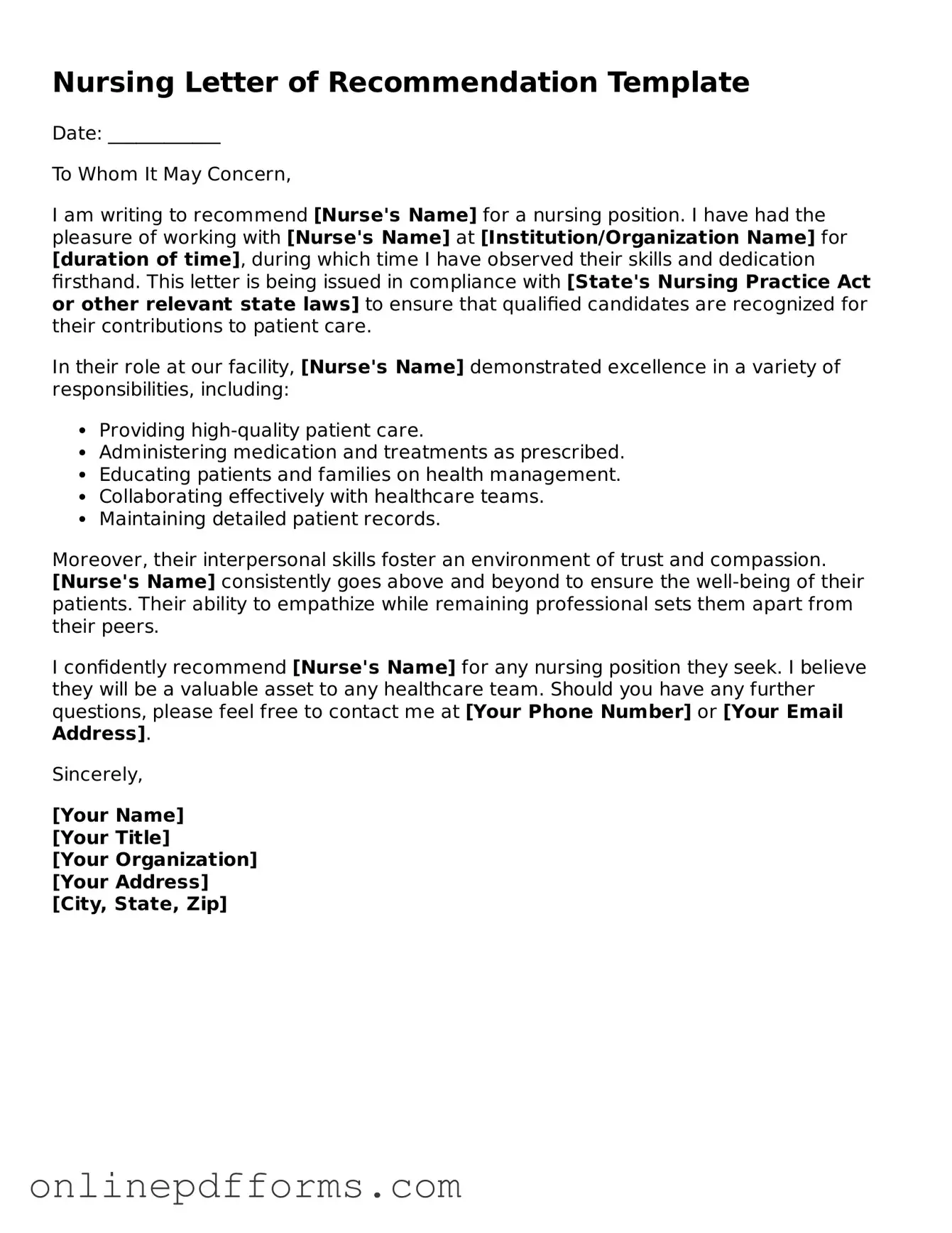The Nursing Letter of Recommendation form shares similarities with the Academic Letter of Recommendation. Both documents aim to highlight an individual's qualifications and character. Academic letters often come from teachers or professors who can attest to a student's abilities, much like how a nursing recommendation is provided by supervisors or colleagues who can speak to a nurse's skills and work ethic. Each letter focuses on specific attributes that make the candidate suitable for their respective fields, emphasizing personal experiences and accomplishments.
Another document akin to the Nursing Letter of Recommendation is the Employment Reference Letter. This letter is typically written by a former employer or supervisor to provide insights into a candidate's work performance and professional demeanor. Just as in nursing recommendations, these letters detail the individual's contributions, strengths, and areas of expertise, helping potential employers or educational institutions gauge the candidate's fit for a role or program.
The Character Reference Letter also parallels the Nursing Letter of Recommendation in its focus on personal attributes. This type of letter is often written by someone who knows the candidate well, such as a friend or community leader. While it may not be job-specific, it highlights qualities like integrity, reliability, and interpersonal skills, which are equally important in nursing. Both documents aim to paint a comprehensive picture of the individual beyond just their professional qualifications.
A Professional Recommendation Letter is another document that resembles the Nursing Letter of Recommendation. It is typically written by someone in the same industry who can provide insight into the candidate's professional capabilities. Like nursing recommendations, these letters often include specific examples of the candidate's achievements and contributions to their field, demonstrating their readiness for new challenges or opportunities.
The Graduate School Recommendation Letter is similar as well, particularly for nurses seeking advanced education. These letters are crafted by academic or professional mentors who can speak to a candidate's readiness for graduate-level study. Both documents emphasize the candidate's potential for growth and success in their respective fields, providing valuable context for admissions committees.
Additionally, the Volunteer Reference Letter shares common ground with the Nursing Letter of Recommendation. This type of letter highlights an individual's commitment and contributions in a volunteer capacity. Just as a nursing recommendation underscores clinical skills and teamwork, a volunteer reference illustrates the candidate's dedication, compassion, and ability to work collaboratively in diverse environments.
The Nursing Letter of Recommendation form is essential for showcasing a candidate's abilities within the healthcare field, emphasizing their specific competencies while adhering to standard letter formats. To ensure that all pertinent information is conveyed effectively, it can be helpful to refer to additional resources, such as the useful template found at https://fillable-forms.com/blank-recommendation-letter, which outlines the standard structure and key elements to include in such documents.
The Personal Statement, while more narrative in style, serves a similar purpose in showcasing an individual's journey and motivations. While it is typically a self-written document, it often includes themes and experiences that might also be highlighted in a nursing recommendation. Both documents aim to convey the candidate's passion for their field and their commitment to making a positive impact.
The Teaching Reference Letter is another document that resembles the Nursing Letter of Recommendation. Written by educators or administrators, it emphasizes a teacher's ability to connect with students and facilitate learning. Similar to nursing recommendations, these letters focus on interpersonal skills, dedication, and the ability to thrive in a challenging environment, making them valuable for those pursuing educational roles.
Lastly, the Fellowship Recommendation Letter is comparable to the Nursing Letter of Recommendation for individuals applying for fellowships or specialized training. These letters are written by professionals who can attest to the candidate's qualifications and potential for success in a competitive program. Both documents highlight the candidate's unique strengths and experiences, providing a strong endorsement for their future endeavors.
